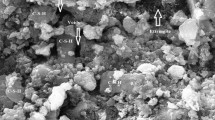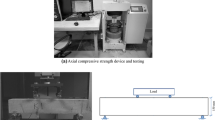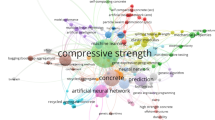Abstract
Compressive strength of concrete is one of the most determinant parameters in the design of engineering structures. This parameter is generally determined by conducting several tests at different ages of concrete in spite of the fact that such tests are not only costly but also time-consuming. As an alternative to these tests, machine learning (ML) techniques can be used to estimate experimental results. However, the dependence of compressive strength on different parameters in the fabrication of concrete makes the prediction problem challenging, especially in the case of concrete with partial replacements for cement. In this investigation, an extreme learning machine (ELM) is combined with a metaheuristic algorithm known as grey wolf optimizer (GWO) and a novel hybrid ELM-GWO model is proposed to predict the compressive strength of concrete with partial replacements for cement. To evaluate the performance of the ELM-GWO model, five of the most well-known ML models including an artificial neural network (ANN), an adaptive neuro-fuzzy inference system (ANFIS), an extreme learning machine, a support vector regression with radial basis function (RBF) kernel (SVR-RBF), and another SVR with a polynomial function (Poly) kernel (SVR-Poly) are developed. Finally, the performance of the models is compared with each other. The results of the paper show that combining the ELM model with GWO can efficiently improve the performance of this model. Also, it is deducted that the ELM-GWO model is capable of reaching superior performance indices in comparison with those of the other models.
















Similar content being viewed by others
References
Topcu IB, Sarıdemir M (2008) Prediction of compressive strength of concrete containing fly ash using artificial neural networks and fuzzy logic. Comput Mater Sci 41(3):305–311
Shariati M et al (2019) Experimental investigation on the effect of cementitious materials on fresh and mechanical properties of self-consolidating concrete. Adv Concr Constr 8(3):225–237
Chopra P, Sharma RK, Kumar M (2016) Prediction of compressive strength of concrete using artificial neural network and genetic programming. Adv Mater Sci Eng
Toghroli A et al (2014) Prediction of shear capacity of channel shear connectors using the ANFIS model. Steel Compos Struct 17(5):623–639
Naderpour H, Rafiean AH, Fakharian P (2018) Compressive strength prediction of environmentally friendly concrete using artificial neural networks. J Build Eng 16:213–219
Antiohos S et al (2007) Improving the performance of ternary blended cements by mixing different types of fly ashes. Cem Concr Res 37(6):877–885
Abdelkader B, El-Hadj K, Karim E (2010) Efficiency of granulated blast furnace slag replacement of cement according to the equivalent binder concept. Cem Concr Compos 32(3):226–231
ASTMC (2012) Standard specification for coal fly ash and raw or calcined natural pozzolan for use in concrete. ASTM Int, West Conshohocken
Faleschini F et al (2015) Valorization of co-combustion fly ash in concrete production. Mater Des 85:687–694
Li G, Zhao X (2003) Properties of concrete incorporating fly ash and ground granulated blast-furnace slag. Cem Concr Compos 25(3):293–299
Suresh D, Nagaraju K (2015) Ground granulated blast slag (GGBS) in concrete–a review. IOSR J Mech Civil Eng 12(4):76–82
Aziz MA-E, Aleem SAE, Heikal M (2012) Physico-chemical and mechanical characteristics of pozzolanic cement pastes and mortars hydrated at different curing temperatures. Constr Build Mater 26(1):310–316
Özbay E, Erdemir M, Durmuş Hİ (2016) Utilization and efficiency of ground granulated blast furnace slag on concrete properties—a review. Constr Build Mater 105:423–434
Bınıci H et al (2012) Investigation of durability properties of concrete pipes incorporating blast furnace slag and ground basaltic pumice as fine aggregates. Scientia Iranica 19(3):366–372
Douglas E, Pouskouleli G (1991) Prediction of compressive strength of mortars made with portland cement-blast-furnace slag-fly ash blends. Cem Concr Res 21(4):523–534
Toghroli A et al (2020) Evaluating the use of recycled concrete aggregate and pozzolanic additives in fiber-reinforced pervious concrete with industrial and recycled fibers. Constr Build Mater 252:118997
Gao W et al (2019) Development of a novel soft-computing framework for the simulation aims: a case study. Eng Comput 35(1):315–322
Singh J et al (2016) A study of soft computing models for prediction of longitudinal wave velocity. Arab J Geosci 9(3):1–11
Öztaş A et al (2006) Predicting the compressive strength and slump of high strength concrete using neural network. Constr Build Mater 20(9):769–775
Alshihri MM, Azmy AM, El-Bisy MS (2009) Neural networks for predicting compressive strength of structural light weight concrete. Constr Build Mater 23(6):2214–2219
Prasad BR, Eskandari H, Reddy BV (2009) Prediction of compressive strength of SCC and HPC with high volume fly ash using ANN. Constr Build Mater 23(1):117–128
Khademi F et al (2017) Multiple linear regression, artificial neural network, and fuzzy logic prediction of 28 days compressive strength of concrete. Front Struct Civ Eng 11(1):90–99
Yaseen ZM et al (2018) Predicting compressive strength of lightweight foamed concrete using extreme learning machine model. Adv Eng Softw 115:112–125
Al-Shamiri AK et al (2019) Modeling the compressive strength of high-strength concrete: an extreme learning approach. Constr Build Mater 208:204–219
Han I-J et al (2019) Learned prediction of compressive strength of GGBFS concrete using hybrid artificial neural network models. Materials 12(22):3708
Golafshani EM, Behnood A, Arashpour M (2020) Predicting the compressive strength of normal and high-performance concretes using ANN and ANFIS hybridized with Grey Wolf Optimizer. Constr Build Mater 232:117266
Sun L et al (2019) Applying a meta-heuristic algorithm to predict and optimize compressive strength of concrete samples. Eng Comput 35:1–13
Ashrafian A et al (2020) Compressive strength of foamed cellular lightweight concrete simulation: new development of hybrid artificial intelligence model. Constr Build Mater 230:117048
Priddy KL, Keller PE (2005) Artificial neural networks: an introduction, vol 68. SPIE Press, Bellingham
Shariati A et al (2020) On transient hygrothermal vibration of embedded viscoelastic flexoelectric/piezoelectric nanobeams under magnetic loading. Adv Nano Res 8(1):49–58
Amiri M et al (2016) A new combination of artificial neural network and K-nearest neighbors models to predict blast-induced ground vibration and air-overpressure. Eng Comput 32(4):631–644
Shariati M et al (2020) Prediction of concrete strength in presence of furnace slag and fly ash using Hybrid ANN-GA (Artificial Neural Network-Genetic Algorithm). Smart Struct Syst 25(2):183
Jain AK, Mao J, Mohiuddin KM (1996) Artificial neural networks: a tutorial. Computer 29(3):31–44
Moosazadeh S et al (2018) Prediction of building damage induced by tunnelling through an optimized artificial neural network. Eng Comput 2:579–591
Shariati M et al (2019) Application of a hybrid artificial neural network-particle swarm optimization (ANN-PSO) model in behavior prediction of channel shear connectors embedded in normal and high-strength concrete. Appl Sci 9(24):5534
Karlik B, Olgac AV (2011) Performance analysis of various activation functions in generalized MLP architectures of neural networks. Int J Artif Intell Expert Syst 1(4):111–122
Mansouri I et al (2017) Analysis of influential factors for predicting the shear strength of a V-shaped angle shear connector in composite beams using an adaptive neuro-fuzzy technique. J Intell Manuf, 1–11
Safa M et al (2016) Potential of adaptive neuro fuzzy inference system for evaluating the factors affecting steel-concrete composite beam's shear strength. Steel Compos Struct 21(3):679–688
Shariati A et al (2020) Effect of residual surface stress on parametrically excited nonlinear dynamics and instability of viscoelastic piezoelectric nanoelectromechanical resonators. Eng Comput 36:1–16
Shariati A et al On the nonlinear dynamics of viscoelastic graphene sheets conveying nanoflow: parametric excitation analysis. Mech Des Struct Mach, 1–18
Jang J-S (1993) ANFIS: adaptive-network-based fuzzy inference system. IEEE Trans Syst Man Cybern 23(3):665–685
Petković D et al (2014) Adaptive neuro-fuzzy maximal power extraction of wind turbine with continuously variable transmission. Energy 64:868–874
Petković D et al (2012) Adaptive neuro-fuzzy estimation of conductive silicone rubber mechanical properties. Expert Syst Appl 39(10):9477–9482
Jovic S et al (2019) Potential of adaptive neuro-fuzzy methodology for investigation of heat transfer enhancement of a minichannel heat sink. Phys A Stat Mech Appl 523:516–524
Jovic S et al (2019) Analysing of exchange rate and gross domestic product (GDP) by adaptive neuro fuzzy inference system (ANFIS). Phys A Stat Mech Appl 513:333–338
Khajeh A, Modarress H, Rezaee B (2009) Application of adaptive neuro-fuzzy inference system for solubility prediction of carbon dioxide in polymers. Expert Syst Appl 36(3):5728–5732
Mayilvaganan MK, Naidu K (2011) Comparison of membership functions in adaptive-network-based fuzzy inference system (ANFIS) for the prediction of groundwater level of a watershed. J Comput Appl Res Dev 1:35–42
Shariati M et al (2020) Identification of the most influencing parameters on the properties of corroded concrete beams using an adaptive neuro-fuzzy inference system (ANFIS). Steel Compos Struct 34(1):155
Naghipour M et al (2020) Effect of progressive shear punch of a foundation on a reinforced concrete building behavior. Steel Compos Struct 35(2):279–294
Shariati M et al (2020) Monotonic behavior of C and L shaped angle shear connectors within steel-concrete composite beams: an experimental investigation. Steel Compos Struct 35(2):237–247
Shariati A et al (2020) Investigation of microstructure and surface effects on vibrational characteristics of nanobeams based on nonlocal couple stress theory. Adv Nano Res 8(3):191–202
Shariati A et al (2020) Nonlinear dynamics and vibration of reinforced piezoelectric scale-dependent plates as a class of nonlinear Mathieu-Hill systems: parametric excitation analysis. Eng Comput 36:1–17
Toghroli A et al (2018) Evaluation of the parameters affecting the Schmidt rebound hammer reading using ANFIS method. Comput Concrete 21(5):525–530
Cortes C, Vapnik V (1995) Support-vector networks. Mach Learn 20(3):273–297
Vapnik V, Golowich SE, Smola A (1996) Support vector method for function approximation, regression estimation, and signal processing. In: Advances in neural information processing systems, vol 9. Citeseer
Safa M et al (2020) Development of neuro-fuzzy and neuro-bee predictive models for prediction of the safety factor of eco-protection slopes. Stat Mech Appl Phys A 2:124046
Sedghi Y et al (2018) Application of ANFIS technique on performance of C and L shaped angle shear connectors. Smart Struct Syst 22(3):335–340
Sadeghipour Chahnasir E et al (2018) Application of support vector machine with firefly algorithm for investigation of the factors affecting the shear strength of angle shear connectors. Smart Struct Syst 22(4):413–424
Hussain M et al (2011) A comparison of SVM kernel functions for breast cancer detection. In: 2011 eighth international conference computer graphics, imaging and visualization. IEEE
Huang G-B, Zhu Q-Y, Siew C-K (2006) Extreme learning machine: theory and applications. Neurocomputing 70(1):489–501
Huang G-B (2003) Learning capability and storage capacity of two-hidden-layer feedforward networks. IEEE Trans Neural Netw 14(2):274–281
Shariati M et al (2019) Application of extreme learning machine (ELM) and genetic programming (GP) to design steel-concrete composite floor systems at elevated temperatures. Steel Compos Struct 33(3):319–332
Shariati M et al (2020) A novel approach to predict shear strength of tilted angle connectors using artificial intelligence techniques. Eng Comput 36:1–21
Mansouri I et al (2019) Analysis of influential factors for predicting the shear strength of a V-shaped angle shear connector in composite beams using an adaptive neuro-fuzzy technique. J Intell Manuf 30(3):1247–1257
Toghroli A (2015) Applications of the ANFIS and LR Models in the prediction of shear connection in composite beams. Jabatan Kejuruteraan Awam, Fakulti Kejuruteraan, Universiti Malaya
Katebi J et al (2019) Developed comparative analysis of metaheuristic optimization algorithms for optimal active control of structures. Eng Comput 35:1–20
Armaghani DJ et al (2020) Hybrid ANN-based techniques in predicting cohesion of sandy-soil combined with fiber. Geomech Eng 20(3):191
Shariati M et al (2019) Moment-rotation estimation of steel rack connection using extreme learning machine. Steel Compos Struct 31(5):427–435
Mirjalili S, Mirjalili SM, Lewis A (2014) Grey wolf optimizer. Adv Eng Softw 69:46–61
Muro C et al (2011) Wolf-pack (Canis lupus) hunting strategies emerge from simple rules in computational simulations. Behav Proc 88(3):192–197
Mohammadhassani M et al (2014) An evolutionary fuzzy modelling approach and comparison of different methods for shear strength prediction of high-strength concrete beams without stirrups. Smart Struct Syst Int J 14(5):785–809
Yeh I-C (2003) Prediction of strength of fly ash and slag concrete by the use of artificial neural networks. J Chin Inst Civil Hydraul Eng 15(4):659–663
Yeh I-C (2003) A mix proportioning methodology for fly ash and slag concrete using artificial neural networks. Chung Hua J Sci Eng 1(1):77–84
Yeh I-C (1998) Modeling of strength of high-performance concrete using artificial neural networks. Cem Concr Res 28(12):1797–1808
Yeh I-C (1998) Modeling concrete strength with augment-neuron networks. J Mater Civ Eng 10(4):263–268
Yeh I-C (1999) Design of high-performance concrete mixture using neural networks and nonlinear programming. J Comput Civ Eng 13(1):36–42
Yeh I-C (2006) Analysis of strength of concrete using design of experiments and neural networks. J Mater Civ Eng 18(4):597–604
Sola J, Sevilla J (1997) Importance of input data normalization for the application of neural networks to complex industrial problems. IEEE Trans Nucl Sci 44(3):1464–1468
Legates DR, McCabe GJ Jr (1999) Evaluating the use of “goodness-of-fit” measures in hydrologic and hydroclimatic model validation. Water Resour Res 35(1):233–241
Willmott CJ (1981) On the validation of models. Phys Geogr 2(2):184–194
Nash JE, Sutcliffe JV (1970) River flow forecasting through conceptual models part I—a discussion of principles. J Hydrol 10(3):282–290
Lourakis MI (2005) A brief description of the Levenberg-Marquardt algorithm implemented by levmar. Found Res Technol 4(1):1–6
Moré JJ (1978) The Levenberg–Marquardt algorithm: implementation and theory. In: Numerical analysis, pp 105–116. Springer
Xu C, Zhang X, Haido JH, Mehrabi P, Shariati A, Mohamad ET, Hoang N, Wakil K (2019) Using genetic algorithms method for the paramount design of reinforced concrete structures. Struct Eng Mech 71(5):503–513
Mohammadhassani M et al (2013) Identification of a suitable ANN architecture in predicting strain in tie section of concrete deep beams. Struct Eng Mech 46(6):853–868
Khorami M et al (2017) Seismic performance evaluation of buckling restrained braced frames (BRBF) using incremental nonlinear dynamic analysis method
Author information
Authors and Affiliations
Corresponding author
Additional information
Publisher's Note
Springer Nature remains neutral with regard to jurisdictional claims in published maps and institutional affiliations.
Rights and permissions
About this article
Cite this article
Shariati, M., Mafipour, M.S., Ghahremani, B. et al. A novel hybrid extreme learning machine–grey wolf optimizer (ELM-GWO) model to predict compressive strength of concrete with partial replacements for cement. Engineering with Computers 38, 757–779 (2022). https://doi.org/10.1007/s00366-020-01081-0
Received:
Accepted:
Published:
Issue Date:
DOI: https://doi.org/10.1007/s00366-020-01081-0




